Introduction
Avatar: Frontiers of Pandora is the second major video game entry in the world envisioned by James Cameron with his movie named “Avatar” back in 2009, the first being a now-delisted game from Ubisoft as well. The film was considered a breakthrough in CGI cinematography on a big screen back then, and the sequel “Avatar: The Way of Water” from 2022 is equally so. Say what you will about the actual story and direction of these movies, but the world built up by Cameron is a rich lush place with aesthetic elements to please the eyes: the world of Pandora. And this game does an incredible job of recreating that aesthetic as we’ll soon see in the review breakdown below.

We here haven’t even watched the recent Avatar movie nor are fans of the original, but that is no pre-requisite to enjoying this game apart from some easter eggs thrown in. So worry not if you have no idea or care about the Avatar movies, this game can be enjoyed as is. On the other hand, if you do like those movies, well you’ll have an even better time.
Developers Massive Entertainment, a subsidiary of Ubisoft responsible for the well-received Division series as well as the upcoming Star Wars Outlaws, have come out with their engines revving with this game in what can frankly be considered a surprise end-of-the-year drop. Under the radar till now, partly due to the marketing not being as strong for this game compared to say the Assassin’s Creed series.
Utilizing the incredible in-house Snowdrop engine with even more updates since the Division, including amazing ray tracing implementation not present in those games, this game is without a doubt one of the best-looking games of the year. (Even featuring the “Unobtanium” hidden settings which pushes the RTX 4090 down to 31 FPS and is meant to be a future-proof benchmarking setting) It also has its downsides, of course, so let’s go ahead and dive into the different elements of the game and see what makes it, what breaks it, and most importantly: Should you buy it?
Story
You play as a “Na’vi”, the native species of the planet- no wait, moon “Pandora”. (Being on the moon translates to some incredible imagery such as being able to see the giant planet you orbit in the middle of the night, which is a sight to behold)
Being enrolled in something called “The Ambassador Program” (TAP) since childhood, you’re nuanced in both the ways of the human and the Na’vi. The TAP is something that was established by the RDA (The Resources Development Administration: a fictional organization that plays the role of the antagonist in the movies as well as here), to raise young Na’vi in the human cultural sphere and train them to become RDA envoys to the various clans and communities on Pandora. This would further the RDA agenda of taking over the moon non-violently while also letting the Na’vi benefit from human advancements.
But things get sour between the humans and the Na’vi, taking on from the events of the movie, and the program starts leaning towards military and covert skills to be used in this more confrontational landscape. Years into the future, your character manages to escape from the TAP facility in a fun little tutorial section, and you become part of what’s called the “Resistance” in the Western Frontier. The Resistance’s goals are straightforward: stop the RDA from further establishing a foothold in this previously unseen part of Pandora and polluting the land, destroying the wildlife, disrupting the natural balance, et al.
Being a child of two worlds, you’re uniquely situated in being able to understand this conflict from both sides and hence using that knowledge to help end it, while simultaneously figuring out more about your traditional clan called the “Sarentu” in a journey of self-discovery.
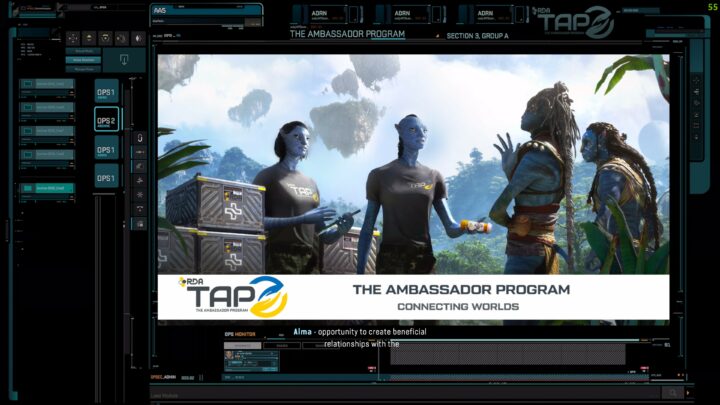
As far as the connection to the actual movies goes, there are a few easter eggs thrown in here and there for people familiar with the movies to notice, but nothing you need to know as a pre-requisite before getting into this game as mentioned in the intro. In terms of the timeline, this game canonically takes place alongside the movies, but on a different continent of Pandora, and is set in the year 2169 (a year before the main events of Avatar: The Way of Water).
All of this is a nice roundabout way to set you up, the player character, against some good hordes of video game enemies to take down, the RDA. And it works out pretty well for the most part.
Gameplay Elements and UI
Let’s get into the meat of the game, its gameplay. Right from when it was revealed that this game was a Ubisoft undertaking, online opinions were flooded with memes of “Far Cry but as Na’vi”, poking fun at the often repetitive open-world formula that Ubisoft games have come to be infamously known for. So does it stand up to those memes, is this another “Ubisoft open-world game”? Thankfully, not really. The game design has a lot of elements worth appreciating and a lot of player control over various aspects to tweak to one’s satisfaction. And the gameplay honestly feels closer to something like Crysis than Far Cry, for reasons we’ll see below.
But before we get into the gameplay, we gotta talk menu and UI. This game features some of the best in-game benchmarks seen in any recent game, with lots of details helping pinpoint the cause of any dropped frames and a neat little timer showing how long is left in the test run.
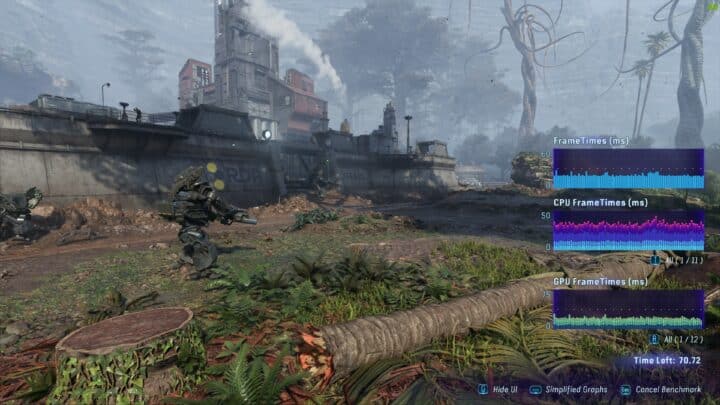
All the menu options have nice indicators below each option showing where we are between the minimum and the maximum, so you don’t have to guess if there’s hidden stuff beyond. The graphics settings especially deserve praise for showing the impact of every setting on the game, with a little visual and text description explaining each setting and also a VRAM usage indicator. Kudos to Massive Entertainment on this.
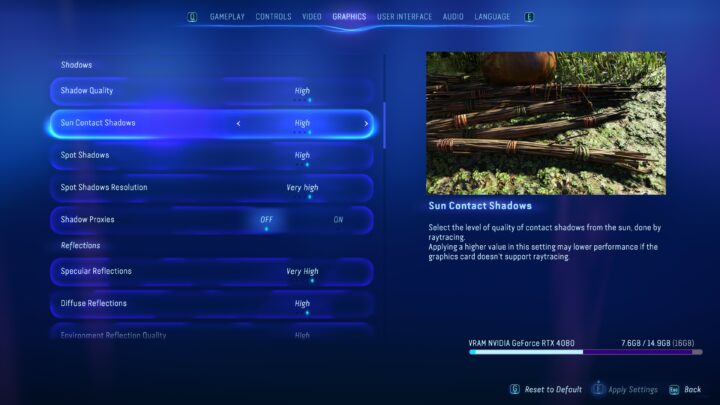
As for the UI, the game by default has a much more “organic” feeling design than other Ubisoft titles. For example, instead of an obtrusive diamond on the screen constantly showing you where to go, you need to use what’s called the “Na’vi senses” (similar to Eagle Vision or Witcher senses) and the objective shows up as a glowing pillar. For players who want even more immersion, the game features an “exploration” mode setting, where even the compass and these other UI elements are kept off and you need to rely on the environmental hints and clues to find your way around. And in a game like Avatar with an incredibly well-crafted world, this is a very fun way to add immersion to the gameplay if you like.
Not everything is perfect in the world of UI here though. One notable issue on PC is having to hold too many buttons at the same time to get to certain menus. For example, if you want to access a particular food item, you need to hold “Q” to open the quick menu, then press “T” to switch to the food menu and then navigate to the food item with your mouse, and THEN hold “F” to consume this food. If you’re already running and using the WASD and shift keys, this results in almost 4 simultaneous button hold just to consume some food. This issue is noticeably less offensive on a controller and it seems designed around one.
This is but a minor nitpick in otherwise generally very well-thought-out and immersive UI, embracing the aesthetic of the Avatar world.
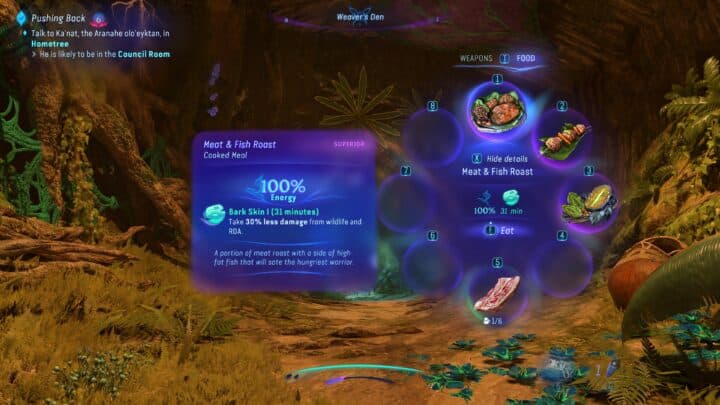
A bunch of neat accessibility options are also tucked away in the menus. There are options for aim assist, to turn off or lower the difficulty of certain minigames (such as a hacking one where you need to direct a dot across a maze to the end, or harvesting where you need to figure out the optimal angle to pull at the resource and more), the aforementioned quest guidance level, combat levels, colored and detailed subtitle options, tinnitus effect reduction and more.
Coming to the actual gameplay, traversal is a significant part of this game. As a consequence, there are a myriad of different skills that can be gained to achieve this. The parkour levels don’t reach that of Dying Light but have just enough added in to make it fun. To start, the jump is not just a fixed tap of the button, but one that varies the distance jumped based on how long it is pressed. There’s also an ability to “double jump”air dash” (double jump) in the air and sprinting helps further the distance jumped. The player can also dash sideways with the tap of the jump and the strafe keys. This helps dodge enemies during encounters in the forests of Pandora.
There is a lot of verticality in the game and environmental features help complement this. Bouncy mushroom pads and leafy launch pads can throw you up into the air, large leaves can help slow down your fall, lift vines can help go up or down and you can make your way across some tree branches to stay hidden from the wildlife or enemies.
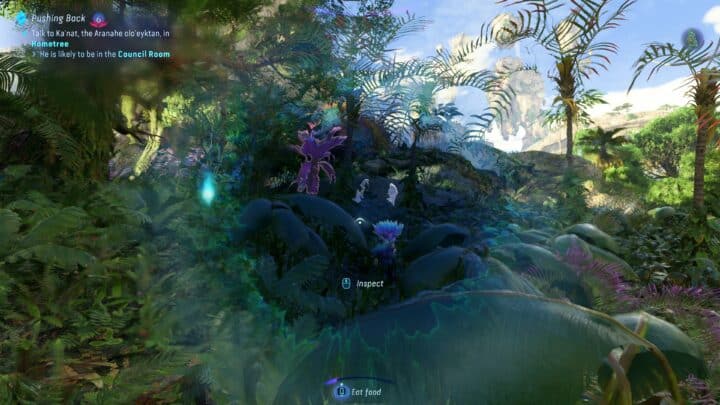
You get access to something called the “Na’vi Senses” early on in the game, which is Eagle Vision or Witcher Senses and a norm in today’s games. However, it is executed pretty well, with any interactive objects showing up as a glow. Each object can be inspected further with a click, adding it to the “Hunter’s Guide” which we’ll talk about below, basically detailing every aspect of the object from its weaknesses to abilities. It can also be used to track down scents of any fauna or enemies around the world.
The health system used here is also intuitive, similar to something like Red Dead Redemption 2, where there is a separate “Energy” bar below the “Health” bar. The higher the energy bar, the more quickly your health regenerates. This meter can be filled by consuming raw or cooked food items, and cooking is an absolute delight in this game as we’ll discuss soon. As expected, cooked items grant better energy levels and also added buffs for a time duration determined by the ingredients.
In cases of a pinch or during combat, the Health bar can be instantly replenished using dedicated med kits or things called “Dapophets” which are used by the Na’vi to heal and can be gathered from Dapophet plants. During exploration, you can also come across special plants called “Bellsprigs” which permanently increase the maximum health by a small amount when touched and are hence valuable exploration points of interest to find.
The environment crafted by Massive Entertainment here is very interactive. Numerous different plants exist each with their characteristics. Some are just passive, some are straight-up aggressive.
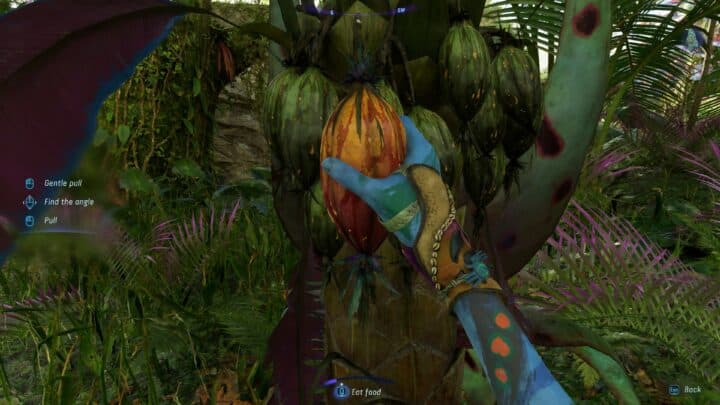
But not all plants are harmful, on the other hand, many offer the opportunity to “gather” elements from them to craft equipment, cook food, or even just donate to camps. Each plant has its conditions of weather depending on the biome which results in the best quality of ingredients. That’s right, the quality of ingredients depends on when it is obtained, but also on how. If you just yank it out at the wrong angle, the quality goes down.
The same goes for all the fauna around. Each one has its collection of weak points which can be targeted for a “clean” kill, in turn granting the highest grade of materials salvaged. Using a violent method such as explosives or even gunfire can ruin these materials, as well as lower the “mercy” killing level. Inflict too much senseless violence upon the local wildlife, and you can be afflicted with a “disharmony” status as a consequence, as the Na’vi are not supposed to kill for sport.
The game even features different biomes, time of day and weather effects each with their own set of flora and fauna to explore. To get the highest quality of ingredients, one needs to locate the appropriate biome under the right weather conditions and time of day. This isn’t as hard as it sounds as the game features resting spots to help pass the time, so one can simply wait until the right conditions strike.
Once these ingredients are collected, we can begin crafting. Crafting in this game comes in a few different ways. There’s the on-the-fly crafting of certain things such as ammunition for arrows, which simply require you to hold Q to open the quick menu, select the weapon and the ammo type in question, and hold the craft button, consuming the necessary raw materials from your inventory. Arrows for example can have a plain type, or an explosive type, each requiring its own set of raw materials that can be gathered from the environment or received from characters. Certain things such as bullets cannot be crafted and need to be looted from various sources or enemies.
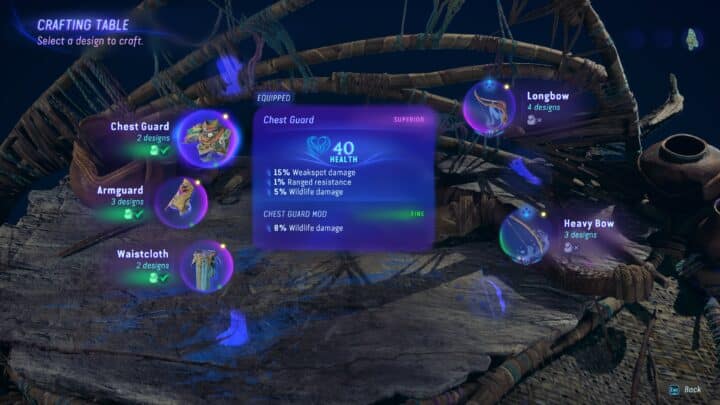
There is also a more intricate crafting system which can be accessed by using a crafting bench at any one of the safe places. These can be used to craft more permanent items, such as weapons, armor, and even modifications to weapons and clothing, each providing its buff. The quality of these crafted equipment depends on the quality of the ingredients used. So if you went ahead and butchered some animals by blowing them up and got a half-burnt rawhide, you’ll get an equally butchered piece of armor to wear. But if you attained a clean kill with a single shot, the crafted armor in turn will be of superior quality offering higher protection and other buffs.
The other form of “crafting” is in fact, cooking. And the cooking in this game is very fun. It is blatantly ripped off from the Zelda series, but that’s a good thing because if it’s fun and some game uses it, more games should use them too (and patenting game ideas is silly and stunts developer creativity). More fun mechanics for more games to enjoy for everyone! But yes, the cooking involves picking two different ingredients and placing them for a mystery cook-off.
One slot determines the type of buff, the other the duration. And a huge variety of different dishes can be experimented with. When cooking with any ingredient for the first time, the result will be unknown and marked with “???”. Once the cooking is completed, the resulting dish is presented with its image, description, and buffs. For example, if you put a certain meat with some fruits, it will create a tasty-looking meat and fruit dish, with buffs derived from the type of meat and fruit used. It may not go your way all the time though. For example, I used a mushroom with some egg to try making a stew, and it turned out to be a disgusting slop which gave my character food poisoning for 20 seconds. As with crafting, “superior” quality ingredients grant even better buffs and durations so gathering good stuff is key.
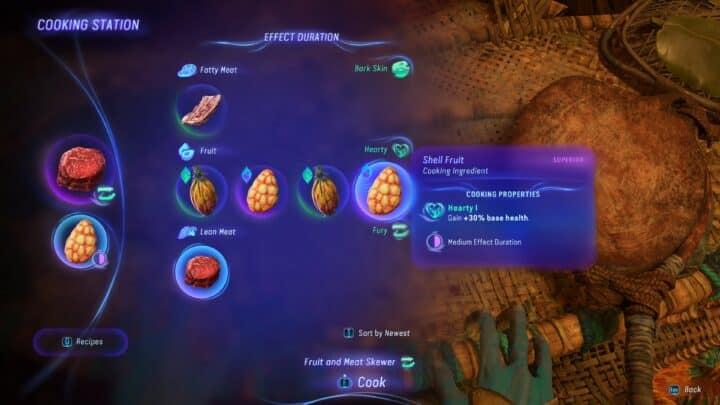
Coming to the crafted items, we need a place to store them. And that’s where the nifty inventory system comes in. The game features separate slots for each piece of equipment, each with its own “level” indicating its overall usefulness for the current mission difficulty. This is similar to a game like Destiny 2 where each piece of equipped thing contributes to your overall level, indicating if you’re ready for a particular mission or not, each being represented by their own recommended power levels. Each enemy of wildlife also has their power level and higher ones are marked with a red glow beneath the number to show they’re not to be trifled with.
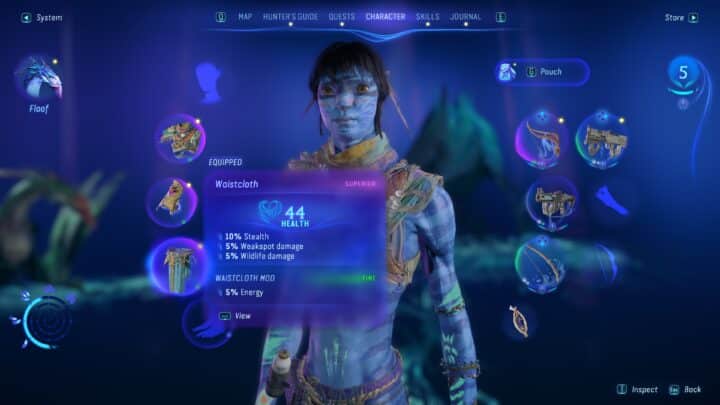
As for all the other materials gathered, they go neatly into a separate “pouch” accessible from the equipment menu. This pouch is also equally neatly sorted, with slots for cooked foods, raw cooking ingredients, raw crafting ingredients, unequipped weapons, mods, and clothing. Everything can also be sorted either by newest, rarity level, alphabetical order, or even combat strength. This is a much-appreciated addition to any inventory and an excellent feature to have. The same “unread message” notification also shows up if you have not checked in on newly gathered items, and each item can also be discarded at any time. Although it is usually better to hold onto them and contribute them at camps for “favors” which we’ll talk about soon.
There is also a whole separate menu for your flying mount, the “Ikran” once it’s unlocked in a mission some ways into the game. Some cosmetics can be applied to each piece of equipment if you wish to change their looks as well.
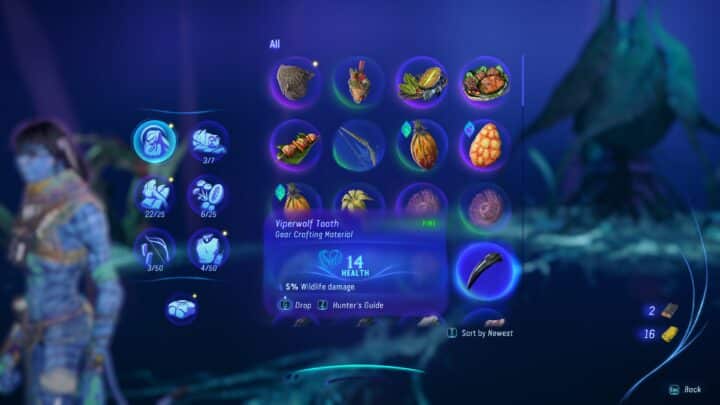
All of these items can be traded in Na’vi safe areas, but not in the traditional sense of trading. Faithful to the Avatar universe, the Na’vi don’t deal with currency. Instead, there is something called the “favor” system. Doing quests, side objectives, talking to the members, and also just contributing whatever you can or do not need, all help increase the favor level with the clans.
These favors can then be used with the “vendors” in these areas, each giving out different types of equipment. Higher-level gear requires more flavor as expected. These members also occasionally give out “gifts” to the player character which do not cost any favor. There’s also a separate section for designs which are blueprints that once attained, can be used to craft your versions of these items in the craft benches as long as you have the necessary ingredients. Crafted equipment is usually better than the ones just received, depending on the quality of ingredients used.
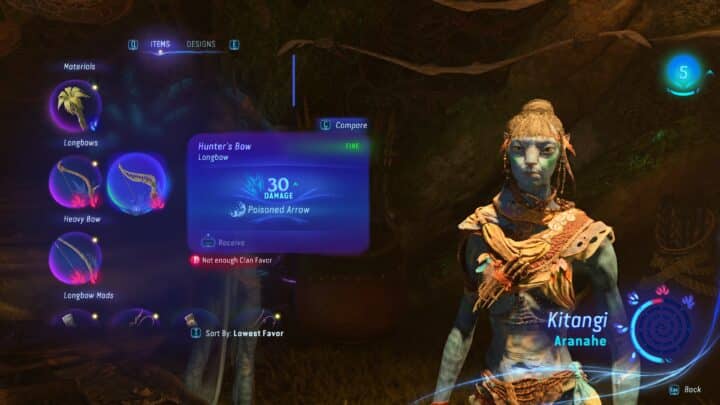
Coming to the combat, the game features a variety of enemies to take down in different ways, each with its weak points which can be scoped with the Na’vi vision. For the most part, you play the giant Na’vi, and most humans can be punched to their demise in a single punch if you so wish. But the game also rewards stealth in many areas. Certain RDA bases require to be shut down, each with its own set of conditions, that are usually very heavily protected. Alerting the enemies causes them to call in reinforcements and swarm you. It’s possible to get out of them with brute force, but using stealth to go in and complete the objectives feels much more rewarding.
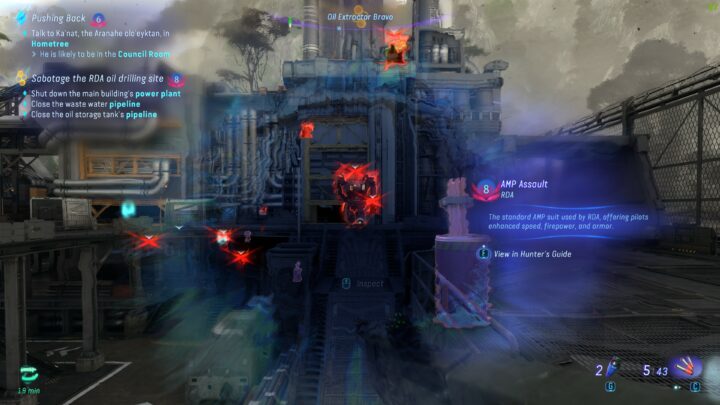
The game gives you a sort of hacking tool, called the SID, which is useful in hacking many of these objectives in quick little minigames while also tracing any electronic or wiring equipment around. It can also be used to hack into enemy weaponry such as turrets or even walking machines with skill upgrades. There is also the option to “store” these hacks, allowing one to execute them all simultaneously to catch the enemy unaware, similar to something in Cyberpunk 2077.
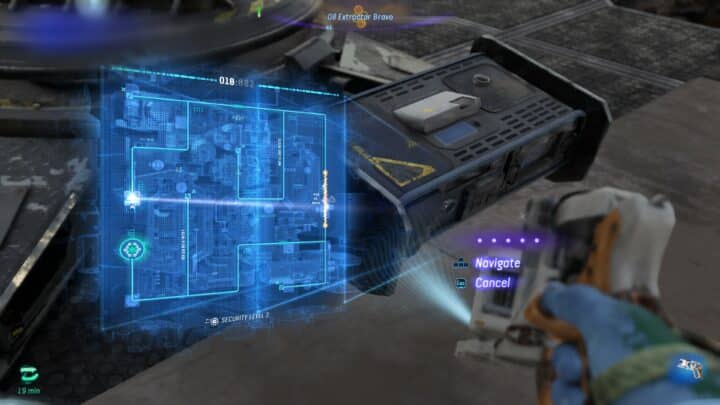
You can also unlock special skills such as one that lets you punch RDA soldiers out of their combat exoskeletons which is particularly fun. A sling can be used to set up mines on the ground of different types. Either an explosive one to wreak havoc or a distraction one that creates noise to call enemies away from an area, to even poisonous ones creating a cloud of gas. The player can also find RPGs in some RDA areas to simply blow up things if they wish. Usually upon completing a base’s objectives, the enemies stop attacking and disappear, so one doesn’t need to take them all out.
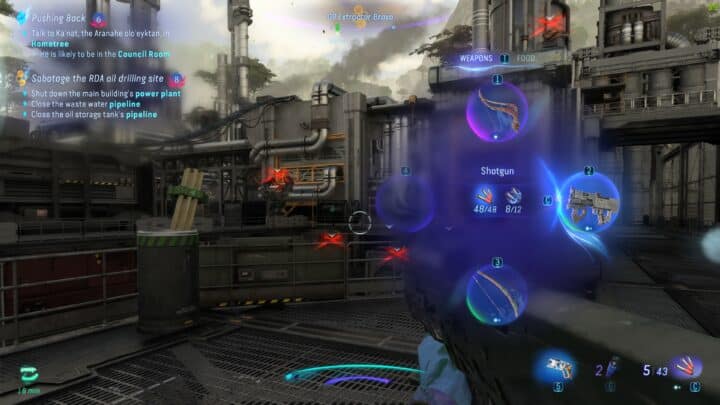
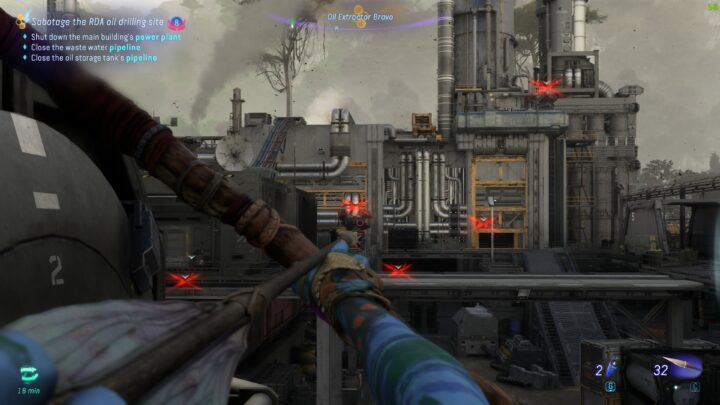
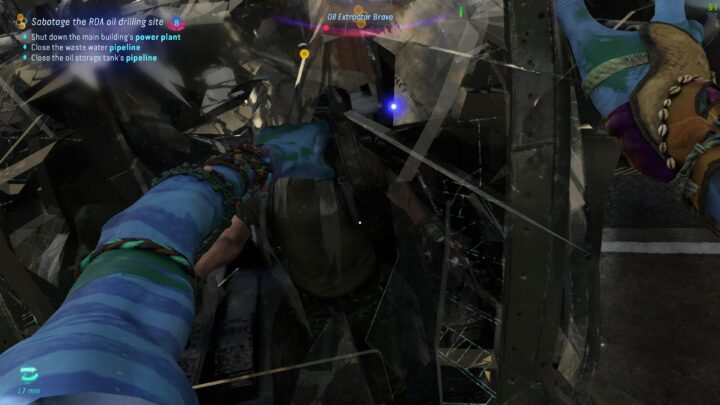
The game also features fun aerial combat once you get your Ikran. You can go up to flying helicopters and shoot arrows or straight up take them down with the help of a skill you can unlock later allowing your mount to grab onto them when staggered. You also get access to “Direhorses” later in the game, which are horses but with no permanent bonding. Each one needs to be soothed before being ridden and can be left behind to find a new one as needed.
The skill tree is once again aesthetically modeled, with 5 different sections, each relating to a certain facet of the Na’vi experience. The “Survivor”, “Warrior”, “Hunter”, “Rider” and the “Maker”. Skill points are earned through exploration and completion of quests. There are also points of interest called “Tarsyu Saplings”, some requiring exploration and solving of environmentally based puzzles (but marked on the map), that grant skill points when touched.
Each of these skill trees has multiple pathways to choose from which get progressively unlocked when the previous one is gained, each with an increasing requirement of the number of skill points needed. All of the skills are aptly described in what they do to the last one, so players can pick and choose which ones to pursue based on their playstyles.
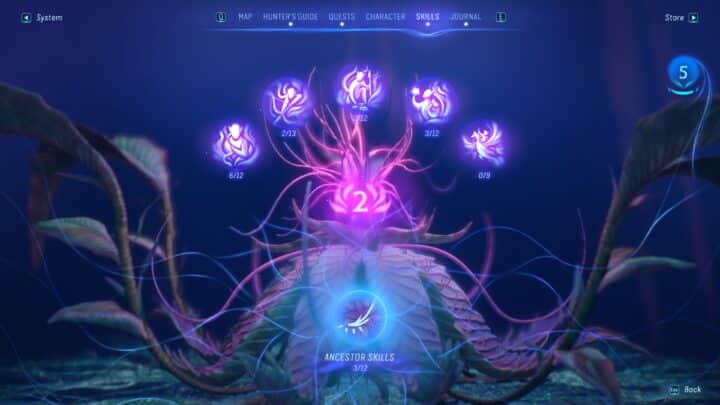
If a particular tree is fully unlocked, an additional “Apex Skill” is made available to be gained, which grants incredible buffs, but requires a few challenges to complete. An example is the Survivor Apex Skill called “Second Wind”, which allows the player to spend energy and be immediately revived after being downed. But the challenge involves hunting some fierce predators flawlessly.
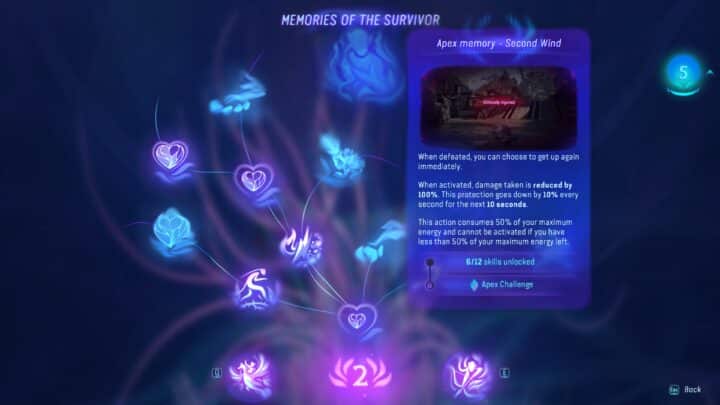
There is also an entire other set of special skills called the “Ancestor Skills” which are powerful and useful game-changing abilities. These are gained by exploring and finding the “Tarsyu Flowers” (similar to the saplings but much bigger and with more parkour needed). An extremely useful and fun one for example is the “Shell Breaker” skill which allows one to pull out the enemy characters from their exo-suits when stunned and is fun to execute. The double jump/air dash is also an ancestor skill gained early on as part of a main mission.
The map is very intricately designed, and unlike games that just feature a plain 2D map, this one features a full 2.5D map. Locations can be seen for their height values as well, useful as this game features a lot of verticality. Completed points of interest get marked with a green dot and can be hidden as well. Personal waypoints can be easily set with a single button which shows up on the compass later.
Players can also create up to 50 custom markers, with 10 different symbol types and 5 different colors, to mark their points of interest to come back to later. There is also an option to switch the biome view, which highlights all the different biomes in different hues, which is useful for gathering ingredients in certain biomes. Areas polluted by the RDA show up as brown and nothing can be harvested in these regions until the offending facility has been shut down by attacking it.
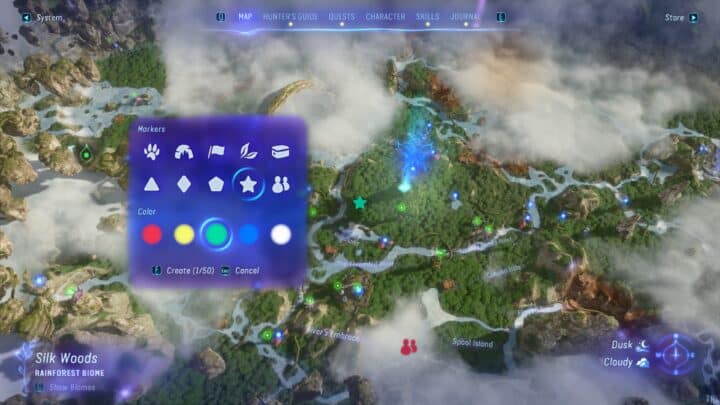
The game also features a fully detailed “Hunter’s Guide” which has data on every flora, fauna, enemy type, and region encountered, as well as specific data on each material gathered. This is very useful when one wants to learn more about the weak points and other data about it. The weak points can be toggled to be seen in this data view, along with their statistics.
If there is any item you wish to find, it can be “pinned” here and it will show up on the compass whenever you’re nearby.
There is a similar separate set of data entries for every character met, piece of knowledge acquired in the world, tutorials, notes, audio logs, crafting recipes, and pretty much everything you need to get up to speed. This is a very useful feature if one wants to brush up on who a particular character was or what a particular recipe said, and more games should have this. It is a Wikipedia page but inside the game and official.
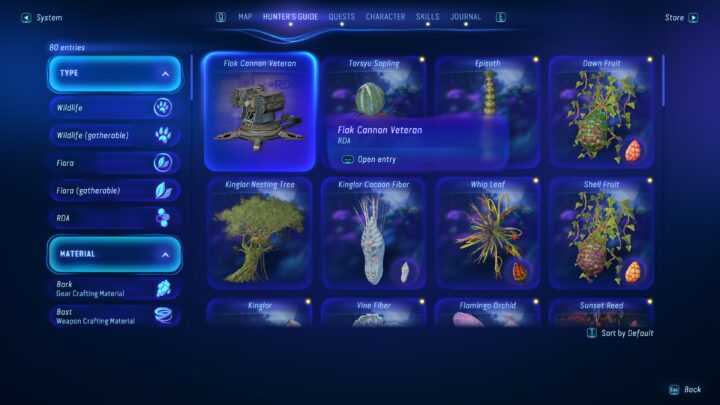
The list of quests can also be tracked from the quests menu, each showing its distance from your current location, a description, and the recommended power level. They can also be sorted by most recent, distance and region types, and viewed on the map to get an idea of where it is.
Finally, there’s also the store, where one can buy cosmetics and patterns to adorn your character with real money. Yes, this is basically what amounts to microtransactions in a game but it is what it is in the current state of the game industry sadly normalizing it. Thankfully this is not obtrusively placed anywhere and is mostly just a button on the side and doesn’t contribute to anything but cosmetics, which some people could be interested in.
As for interactivity, the Na’vi vision is something that works akin to the Eagle Vision or Witcher senses, allowing the player to seek out any nearby flora, fauna, threats, and their weak points as well. Clicking the middle mouse button while focusing on an object allows us to see its description and characteristics including the power level, and adds it to the hunter’s manual if it’s the first time encountering said object. Certain investigation scenes can use this to link different pieces of evidence, similar to the Batman Arkham games, to deduce information. Any animal can also be tracked by its scent, by using this vision.
There’s also a very simple character customization screen, where you can choose the facial features, hairstyles, colors, body type, and voice type for your character. Certain unique body patterns of Na’vi and body paints can also be applied. Anything can be changed at any time during gameplay by visiting the dressing booths inside safe areas, so you won’t be locked within by the choice you make during the initial creation. Considering that this is a primarily first-person experience, this mostly doesn’t add much but is a neat addition to have.
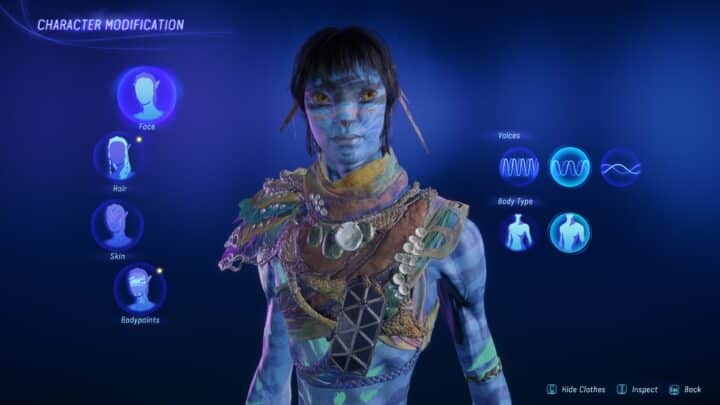
Except of course, for the addition of Co-op where you can see each other’s created characters in all their glory. This game features a very well-made co-op gameplay system for up to 2 players. Unlike the Far Cry series, both players get to carry over the progress of the host as the guest can choose to “skip” the completed missions when they return to their world. All equipment, skills, and materials gained are retained.
It takes a little while to unlock co-op, around more than an hour, and the game even handily tells us which missions need to be completed before access to it is granted. Once available, the game offers a seamless cross-platform co-op experience and in our time trying it out, it was mostly flawless and helped make the gameplay even more fun.
A set of co-op-only options also get unlocked, such as the ability to ping various things with different markers, such as “go there” or “threat here”. And a separate menu for emotes where you can choose to dance in front of your co-op partner while they get mauled by the wildlife. Most gatherable resources are single-instanced, so when one grabs it, the other can’t. Save for the bigger more important loot boxes, so that both players can get access to say a good piece of armor. But you can also swoop in and steal the resources from some animal they downed if you so wish. If you have a friend who has this game, it is highly recommended to play along as it elevates the whole gameplay experience to double the fun and is very well integrated.
Before we close this section, the photo mode deserves a big mention as well. With in-depth options to set up the camera including various special effects, added with the beauty of the Pandorean environment crafted here by the devs, the photos that can be taken are truly impressive. The whole world pauses when entering photo mode.
Environment
We spoke about the environment in brief before, but this is hands down one of the best environments seen in modern games. Most of the objects are destructible. Individual leaves can be shot out or entire trees can be exploded (the smaller ones at least). When HDR is turned on, the game gets even better, so if you have an HDR display use it for this one.
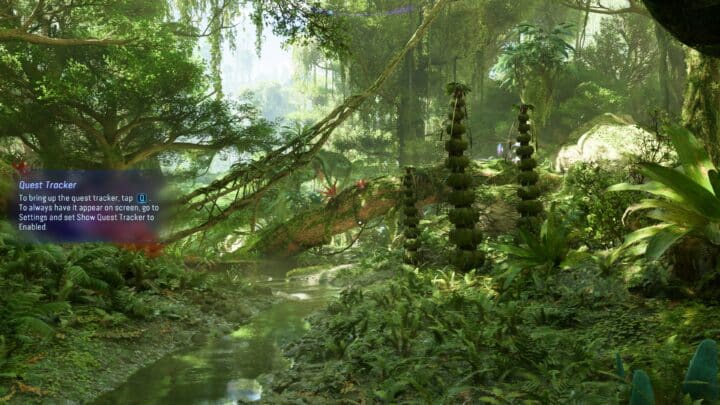
Wind makes everything react in real time and a character running through the foliage evokes a reaction. Along with all the different plant types which can react in different ways. At night time, many elements on the planet take on a glow, such as grass which glows when you walk on it, or the sky with the giant planet in it, with dynamic clouds. When ray tracing is turned on, the global illumination lights up every bit of the forest in all its goodness, and multiple bounces can be seen on most items. Reflection surfaces feature full ray-traced reflections and ambient spaces get lit by all these different bounce lights as well. It is spectacular especially at the highest “unobtanium” settings, if your PC can handle it.
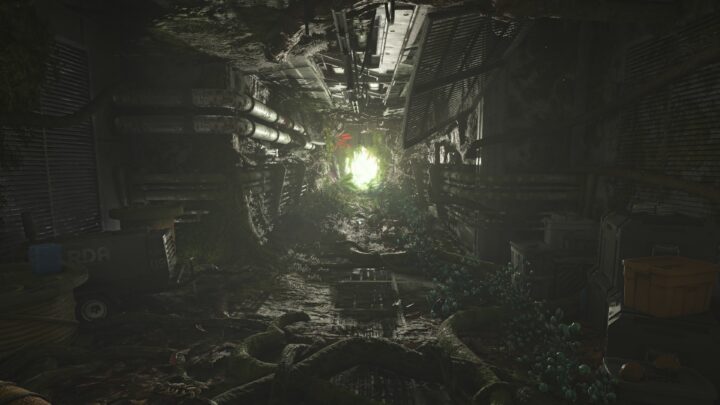
The FSR 3 frame generation implemented here is also some of the best seen to date, and the frames stay at a nice buttery rate with almost no stutters. This is a very finely optimized game on PC and the engine “Snowdrop” is showcased in all its glory, rivaling something like Unreal Engine 5. Of all the elements of the game, the environment is its strongest suit and when soaring through the skies on your mount vertically, the sights can be jaw-dropping.
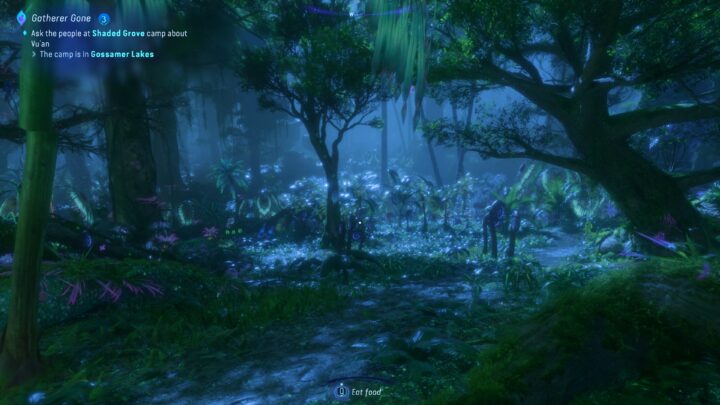
Audio Design
To back up the incredible visuals, the audio design is also pretty strong, with full ray-traced audio in the works. Weapons or objects echo realistically depending on whether you’re inside a cave or out in the open. Footsteps and other sounds can be traced with a high degree of accuracy. And most of the objects have their unique sounds.
The soundtrack also features memorable scores by Pina Toprak, an Emmy-nominated composer, who follows the style of the music featured in the movies with beautiful and spanning sounds encompassing the beauty of Pandora audibly.
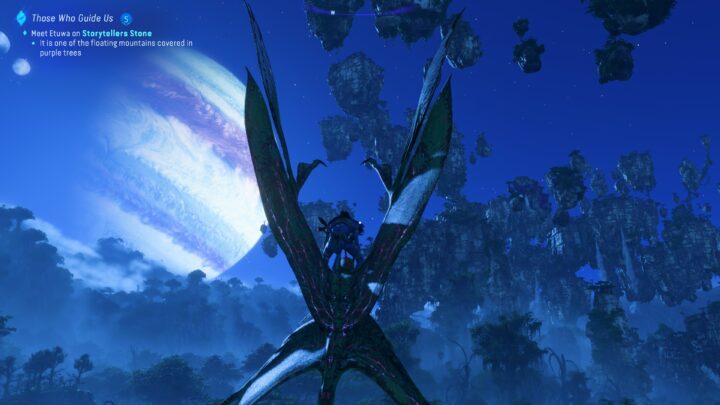
Bugs/Glitches
Massive Entertainment has done an excellent job here finely polishing the game on release. It has become such a frightful and depressing norm to see PC ports get treated like absolute trash with horrible performances on release dates throughout recent years, that seeing a game like this come out with a myriad of different PC-specific settings, features, and smooth performance, is a sight to behold.
Truly, the game runs smoothly, there are no shader compilation stutters, no game-breaking bugs, or even issues in the multiplayer co-op aspect. In our time playing the game, there was nothing more than very minor clipping issues for certain objects during combat. The AI of enemies and the wildlife is tight and believable.
Season Pass Plans and Game Editions
This game features a season pass, which comes with the gold and ultimate editions of the game, and is part of the currently common trend of including such things in a game. Is it worth it? Currently, the plans include a Story Pack 1 coming in the Summer of 2024 titled “The Sky Breaker” and another Story Pack 2 coming in the Fall of 2024 titled “Secrets of the Spires”. There is also a bonus quest “Familiar Echoes” available at launch involving infiltration of a highly secured RDA military base.
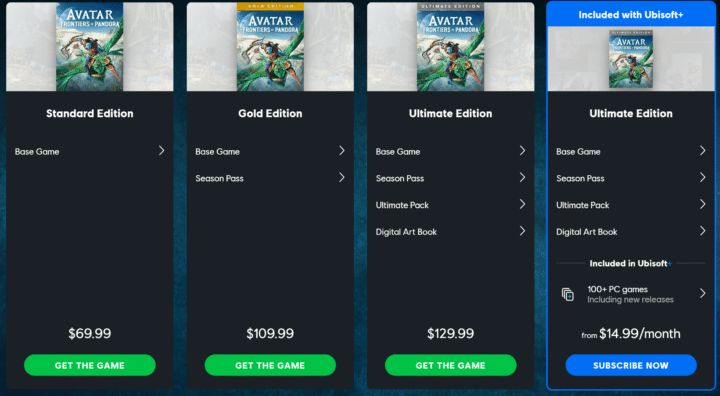
As of now considering the price, which almost effectively doubles just to get these passes, it might be worth waiting to see how they pan out first. Unless you are a huge fan of the Avatar series or like the game, at which point you can upgrade anyway, consider holding off.
The game comes in three editions:
- Standard Edition ($69.99) – Includes just the base game, nothing more, nothing less. A good pick.
- Gold Edition ($109.99) – Includes the base game + the season pass. As mentioned above, you might want to wait to see how things pan out with the season pass DLCs before buying it right away.
- Ultimate Edition ($129.99) – Includes the base game + season pass + “Ultimate Pack” + Digital Art Book. The ultimate pack includes a bunch of cosmetics, such as the Sarentu Heritage Pack consisting of a premium weapon skin, character cosmetic set, and a banshee cosmetic set, and the Sarentu Hunter Equipment Pack, featuring one unique weapon and a character gear set. If you are a sucker for cosmetics in a single-player/co-op game, by all means go for it.
The Digital Art Book is a nice touch though and has some good artwork showing off various things in the game and worth it, although considering the price of the Ultimate Edition being twice of the Standard one, it might not be worth it just to get the art book.
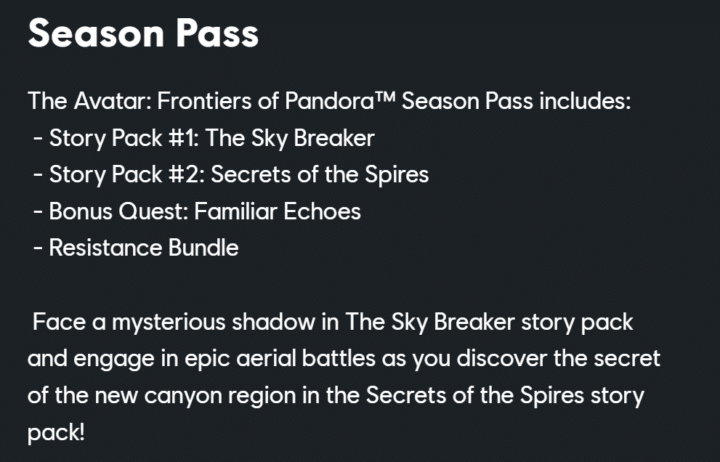
This game is also playable with Ubisoft+, which is Ubisoft’s subscription-based gaming service similar to Game Pass, and at $17.99 per month offering you the Ultimate Edition of the game, this is worth considering. You also get access to a whole host of other Ubisoft titles such as the Assassin’s Creed and Far Cry series and is worth it if you don’t care about owning the games forever and just want to play through it once and be done with it.
Concluding Thoughts
Overall, an excellent entry to the world of Avatar, backed up by incredible visuals, audio, and vibrant environments that capture the wondrous aesthetic of the world of Pandora in all its glory. With a fun combat loop to boot, more akin to Crysis than Far Cry, this game is worth considering especially if you are an Avatar fan. If you have a friend to tag along, the co-op mode makes the game even more fun. In a year filled with broken PC releases and broken promises, this game is a breath of fresh air running flawlessly on PC with barely any bugs at launch.
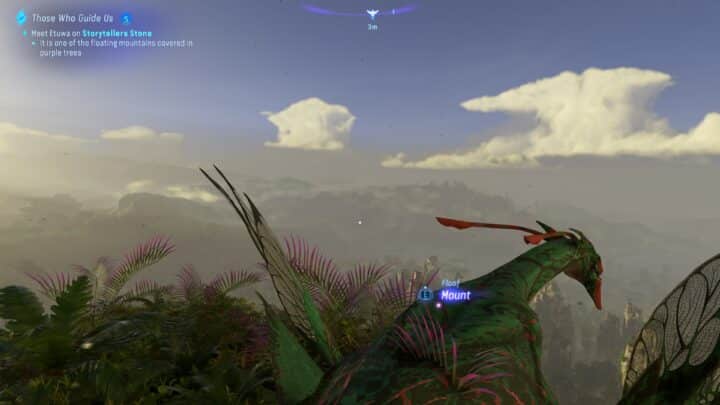
The only drawbacks would be its sorta generic story and characters, and many cutscenes being just people standing around talking. But thankfully the other aspects of the game back it up and save it from falling, with excellent traversal and fun flying mechanics contributing to the joy of exploration. This may not be the best game of the year, but it certainly is the most breathtaking especially if you have the powerful hardware and HDR to boot. If you have the money and love the idea of running around in a lush forest environment and beating up enemies as they come, you’d want to give this a try on PC. And even otherwise, the Ubisoft+ subscription offers a great way to play it without breaking the bank, as this game doesn’t hold much replayability value at the moment.
Our Rating
7.5/10
Ubisoft’s Massive Entertainment has crafted something truly spectacular in terms of environmental and visual storytelling here, with an emphasis on traversal and an involved combat loop to boot, but its straightforward story and characters let it down.
Gallery

























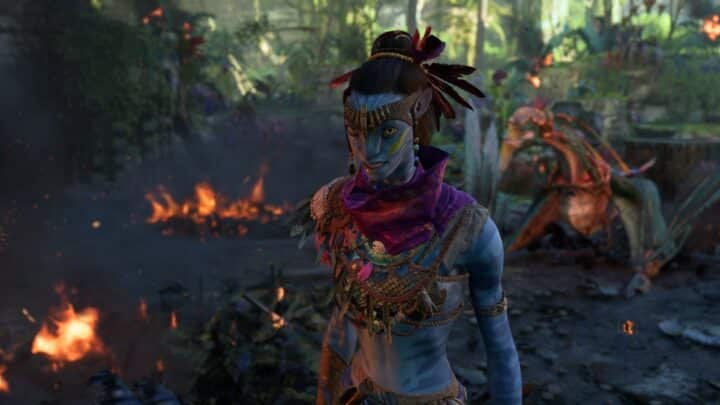
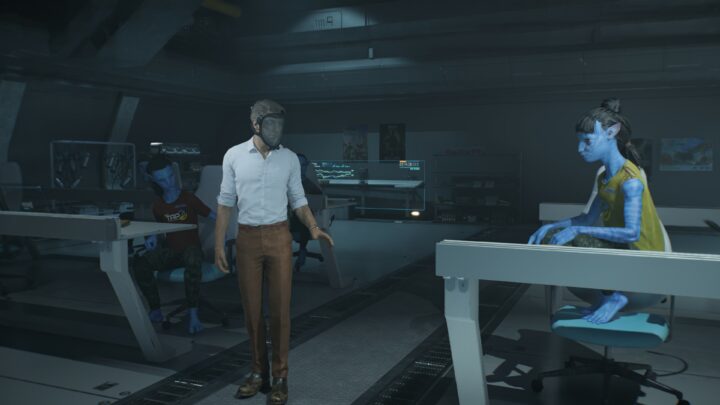

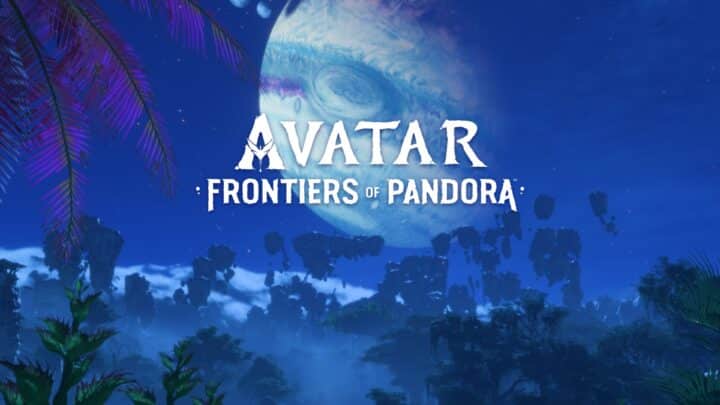
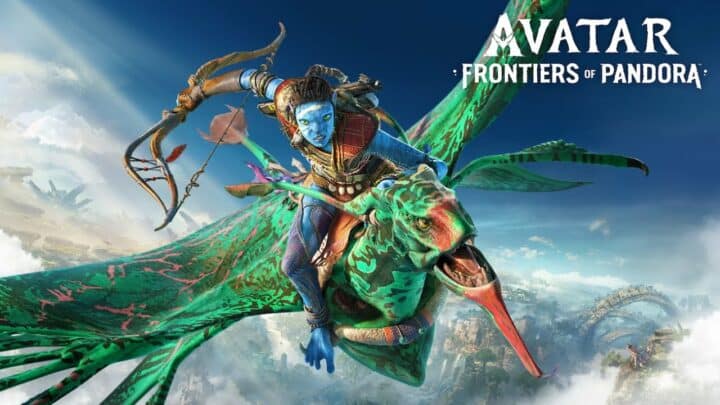
 Sapphire Pulse Radeon RX 7900 GRE Review: AMD’s Best in Action
Sapphire Pulse Radeon RX 7900 GRE Review: AMD’s Best in Action Intel Graphics Driver Boosts Performance by up to 48% on Meteor Lake Processors
Intel Graphics Driver Boosts Performance by up to 48% on Meteor Lake Processors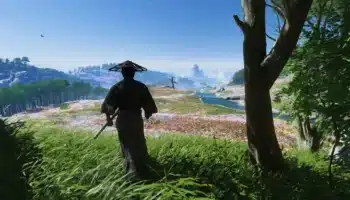 Ghost of Tsushima PC Specs: NVIDIA RTX 4080 for 4K 60 FPS, Likely to Favor AMD Radeon
Ghost of Tsushima PC Specs: NVIDIA RTX 4080 for 4K 60 FPS, Likely to Favor AMD Radeon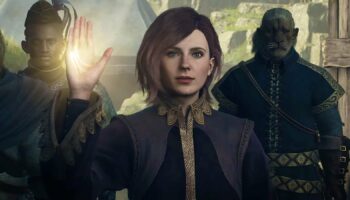 Dragon’s Dogma 2 PC Benchmark Test: AMD RX 7900 XTX Beats the NVIDIA RTX 4090
Dragon’s Dogma 2 PC Benchmark Test: AMD RX 7900 XTX Beats the NVIDIA RTX 4090